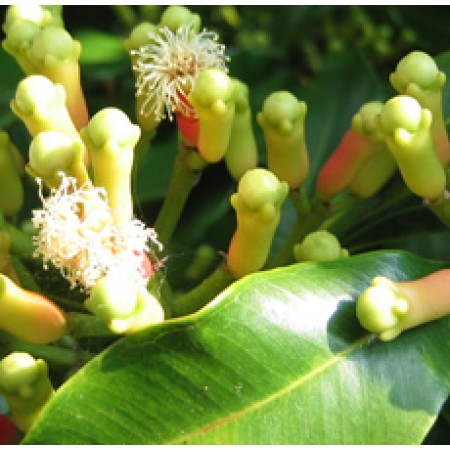Clove Essential Oil (Madagascar)
Product Name: Clove Essential Oil (Madagascar)
Botanic Name: Syzgium aromaticum
Botanical Name: Syzygium aromaticum L.
Extraction Method: Steam Distilled
Description: Clove Bud Essential Oil is derived from the Syzgium
aromaticum tree. It is a slender evergreen that grows up to 12 meters in height
(approximately 36 feet). At the start of the rainy season, long buds appear.
They change color over time and are beaten from the trees and dried. These are
the cloves sold commercially.
Aromatic Scent: Clove Bud Essential Oil smells spicy like actual cloves.
The aroma of this oil is a bit sweeter than the Indonesian variety and slightly
less herbaceous. For this reason, we recommend that you order a sample before
making a larger order.
Common Uses: Cloves are used in Indian Ayurvedic medicine, Chinese
medicine, and western herbalism and dentistry where the essential oil is used
as an anodyne (painkiller) for dental emergencies. Clove Bud oil, applied to a
cavity in a decayed tooth, helps to relieve toothache.The clove essential oil
is used in aromatherapy when stimulation and warming are needed. Topical
application over the stomach or abdomen are said to warm the digestive tract,
to relieve digestive problems.Clove Bud oil is also used in balms to help
improve circulation to soothe muscle aches and pains. Clove oil is the active
ingredient that helps the blood flow through the area and helps to reduce the
pain. Because it helps improve circulation, Clove Bud oil is ideal for reducing
the pain and discomfort typically associated with tension headaches.When used
for aromatherapy purposes, Clove Bud oil helps to stimulate the brain. The
strong aroma of Clove Bud oil helps one to become more attentive and can even
help one feel more energetic than they normally are.
History: The word Clove comes from the Latin word clavus, meaning nail, since the
shaft and head of the clove bud resembles an ancient nail. Cloves and nutmeg
were among the most precious of spices of Europe of the 16th and 17th
centuries, and were worth more than their weight in gold. Today it is used
worldwide as a culinary spice from East Indian masala blends to Dutch cheeses,
in herbal cigarettes and pomanders, and even as an ant repellent.









